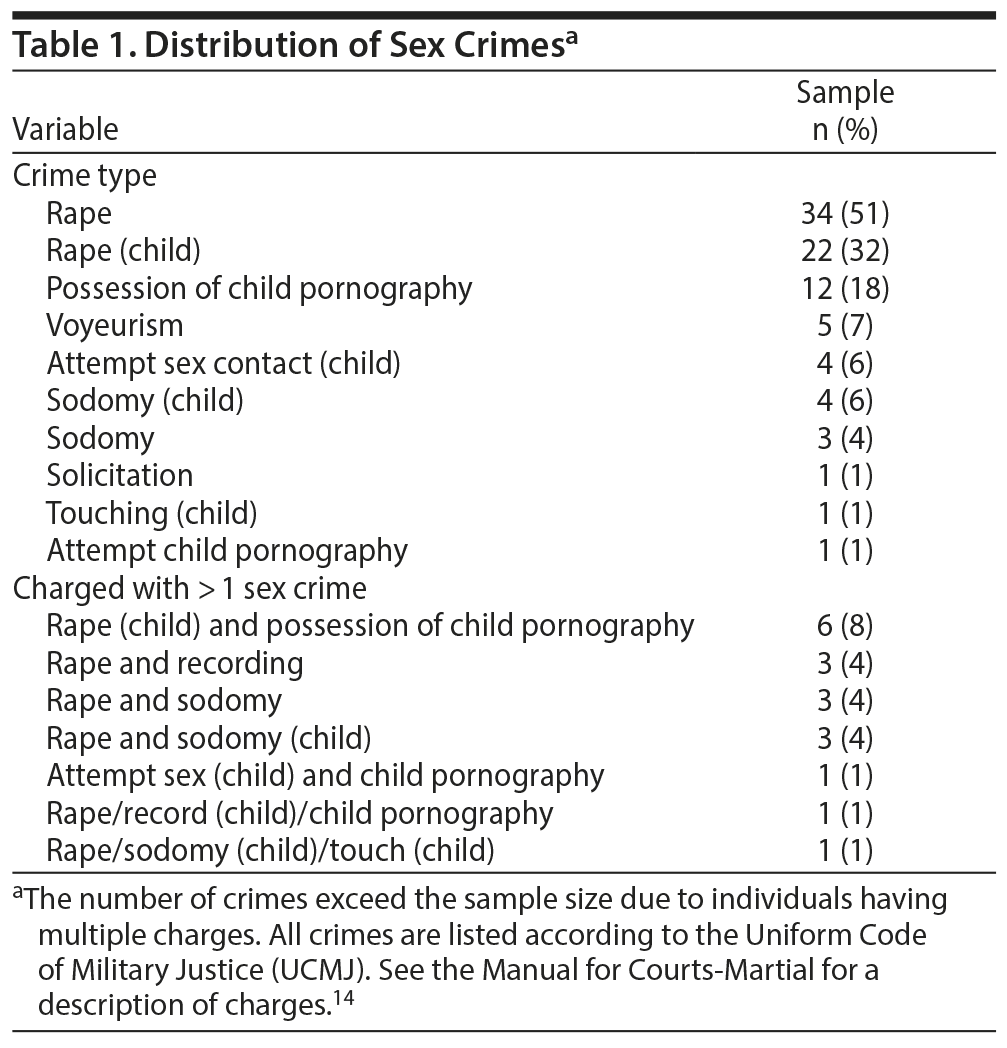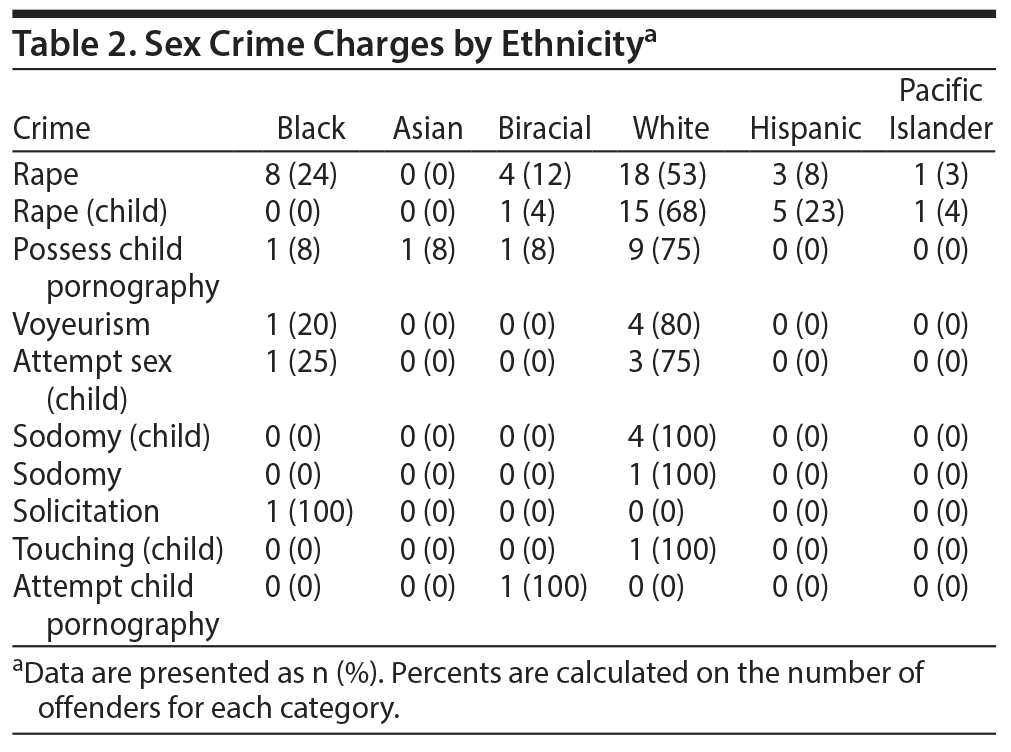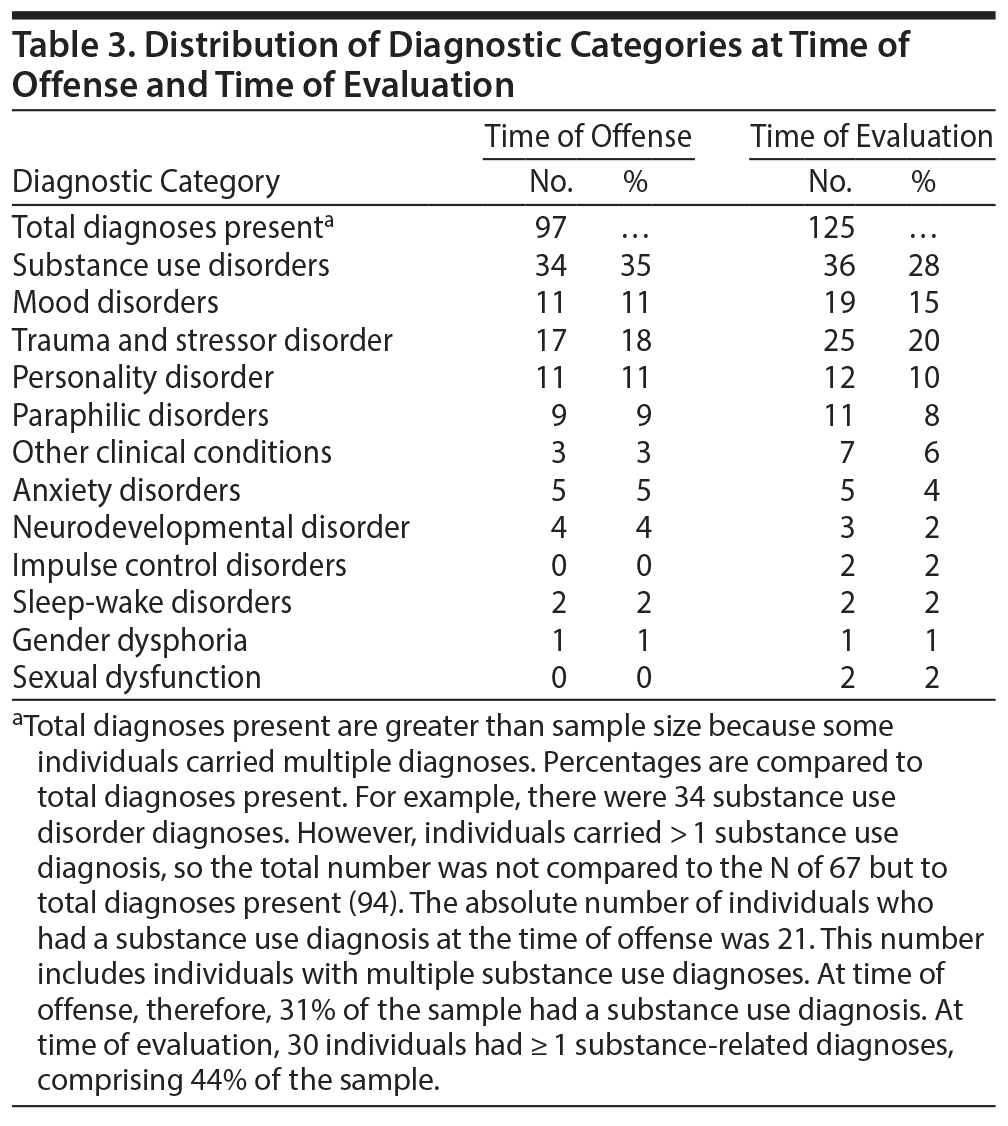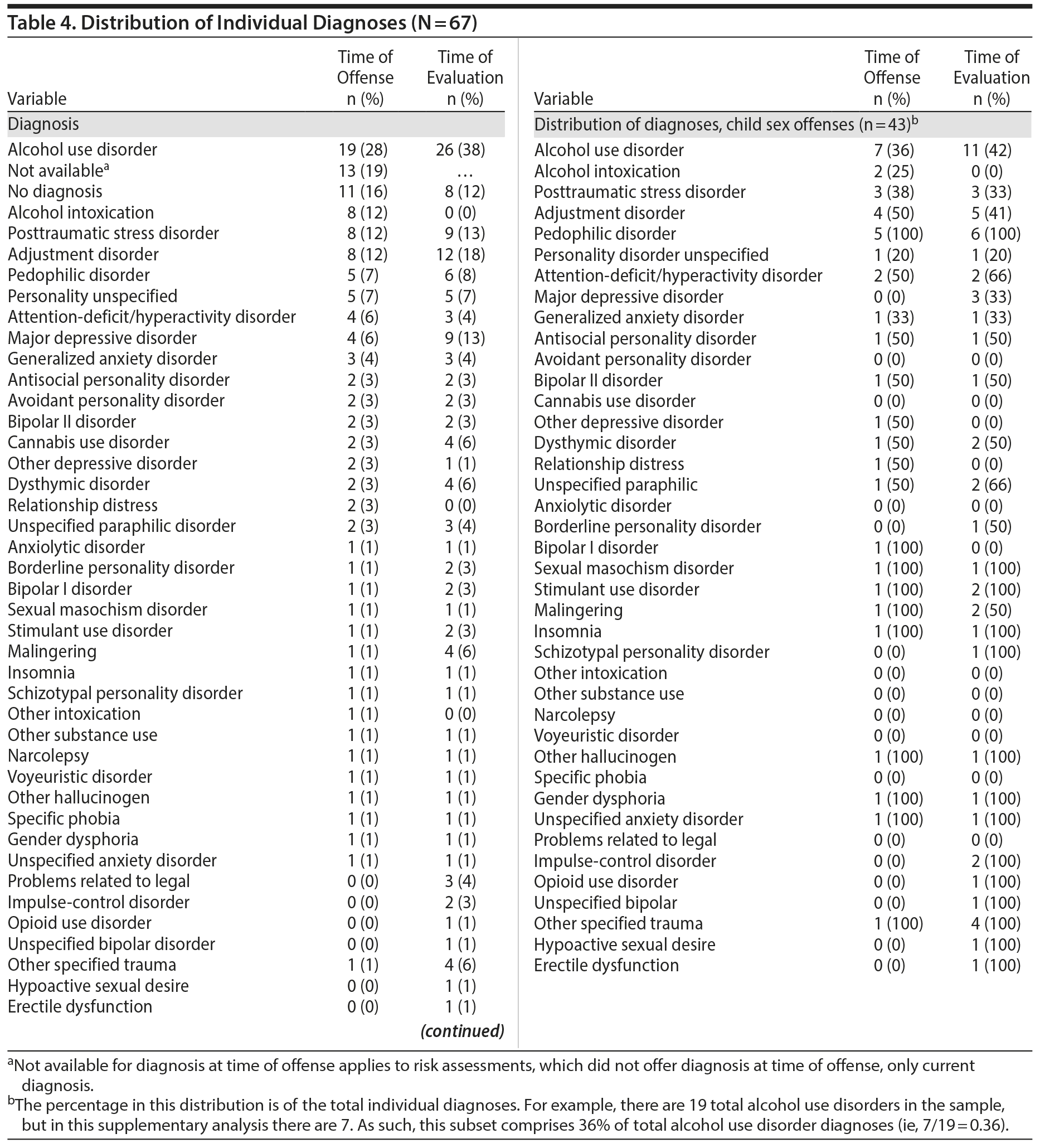Objective: To examine the prevalence of psychiatric disorders among service members charged with sexual offenses.
Methods: The sample comprised service members charged with any type of sexual offense and referred for forensic evaluation (N = 67). Forensic mental health evaluations (competency to stand trial, criminal responsibility, risk assessment) of service members charged with sexual offenses were examined and the assigned clinical diagnoses (according to DSM-IV or -5) were enumerated to provide natural frequencies and percentages. Data were collected from February 2018 to May 2018.
Results: Findings suggest that alcohol use disorder is the most prevalent disorder both at the time of offense (28%) and time of the forensic evaluation (38%). The 2 most prominent diagnostic categories were substance use disorders and trauma-and-stress-related disorders.
Conclusions: Identification and treatment of psychiatric disorders among service members charged with sexual offenses may facilitate rehabilitation, reduce recidivism, and offer public health benefits. This topic should be further studied in a larger sample to effectively address this public health problem.
Psychiatric Comorbidity of Sex Offenses in a Military Forensic Sample

ABSTRACT
Objective: To examine the prevalence of psychiatric disorders among service members charged with sexual offenses.
Methods: The sample comprised service members charged with any type of sexual offense and referred for forensic evaluation (N = 67). Forensic mental health evaluations (competency to stand trial, criminal responsibility, risk assessment) of service members charged with sexual offenses were examined and the assigned clinical diagnoses (according to DSM-IV or -5) were enumerated to provide natural frequencies and percentages. Data were collected from February 2018 to May 2018.
Results: Findings suggest that alcohol use disorder is the most prevalent disorder both at the time of offense (28%) and time of the forensic evaluation (38%). The 2 most prominent diagnostic categories were substance use disorders and trauma-and-stress-related disorders.
Conclusions: Identification and treatment of psychiatric disorders among service members charged with sexual offenses may facilitate rehabilitation, reduce recidivism, and offer public health benefits. This topic should be further studied in a larger sample to effectively address this public health problem.
Prim Care Companion CNS Disord 2019;21(1):18m02349
To cite: Umbrasas KV. Psychiatric comorbidity of sex offenses in a military forensic sample. Prim Care Companion CNS Disord. 2019;21(1):18m02349.
To share: https://doi.org/10.4088/PCC.18m02349
© Copyright 2019 Physicians Postgraduate Press, Inc.
aCenter for Forensic Behavioral Sciences, Walter Reed National Military Medical Center, Bethesda, Maryland
*Corresponding author: Karl Umbrasas, PsyD, Dalecarlia Annex Fremont Bldg, 6000 MacArthur Blvd, Bethesda, MD 20816 ([email protected]).
Research1-3 suggests that sex offenders are consistently diagnosed with psychiatric disorders. Dunsieth et al1 found that 85% of sex offenders in an Ohio rehabilitation program met DSM-IV criteria for a substance use disorder and 74% met criteria for a paraphilia. Over half of sex offenders in their study1 met criteria for a mood disorder (58%), with bipolar disorder being most prominent. Leue et al3 found that 56% of sex offenders in German state forensic hospitals met criteria for a substance use disorder and 69% met criteria for any anxiety disorder, with the most common type of anxiety disorder being simple phobia. Research by L×¥ngstrom et al2 showed a high rate of substance abuse disorders among sex offenders, and Shechory and Ben-David4 found that rapists and child molesters have significantly more state-trait anxiety compared to the general population. Walters5 studied a military prison population and found that sex offenders who victimized children were more likely to have a mood disorder, but sex offenders with adult victims were more likely to have a substance use disorder. Aside from Walters’ limited study5 30 years ago, no current research exists on the psychiatric comorbidity of service members charged with sex offenses.
The prevalence of psychiatric disorder among current service members charged with sexual offenses is unknown. Sex offenders have demonstrated high rates of psychiatric disorder in the civilian population, but the classification of disorder has varied by sample.1,3,6-8 Systematically studying the psychiatric comorbidity of service members charged with sex offenses advances the state of forensic and clinical practice with this population. Currently, research from the civilian forensic population informs practice with service members. It is important, however, to know where divergences and convergences exist between the civilian and military populations. For instance, research shows that sex offenders tend to reliably have certain diagnoses, such as substance abuse disorders, but it is unclear how these prevalence rates compare to the military forensic population.1,3,6-8
Psychiatric diagnoses that reliably occur in a military sex offender population may serve as an identifiable risk factor for recidivism. Social impairment, addiction, or altered mental status may affect an individual’s effectiveness in meeting adult sexual needs and are thus notable in a recidivism management plan. Indeed, social anxiety and feelings of inadequacy are frequently found among sexually delinquent populations.9-11 Yet, due to the lack of systematic research in a military forensic population, it is unclear how much these findings apply to these individuals.
An understanding of the psychiatric comorbidity of service members charged with sexual offenses offers a unique opportunity for preventative efforts through psychopharmacologic and psychosocial treatments targeted to disorders that may influence sexual offending. Mental health clinicians can screen patients whose diagnoses reliably co-occur with sexual offending for factors that might predispose patients to circumstances that contribute to sexual assault. This screening can be done by using base rate data that identify which disorders are more likely to be present at the time of sexual assault. For example, risky interpersonal behavior in the context of a substance use disorder may present a red flag to comprehensively treat psychopathology in an interdisciplinary manner, which may affect sexual assault rates. Prevalence data on this population can be particularly useful at this time, as the US Department of Defense works diligently to address sexual misconduct within its organization.12

- Alcohol use disorder is the most prominent diagnosis among service members charged with sexual offenses.
- Service members who offended against adult victims displayed more psychopathology than service members who offended against children.
The sex offender population in the military has not been objectively described to offer empirical guidelines for management from both a forensic perspective and a treatment perspective. This study will elucidate the prevalence of psychiatric disorder among service members charged with sexual offenses. Literature1-8 has suggested that categories of psychiatric disorder reliably co-occur with sex offenders in a civilian population, but the prevalence of psychiatric disorder has not been studied in a contemporary population of service members charged with this type of offense. The findings from this study can inform strategies that seek to assess, treat, and prevent sexual offenses in the military. The purpose of this retrospective research is to determine the prevalence of psychiatric disorder in a sample of service members charged with sexual offenses.
METHODS
This article presents retrospective research from a convenience sample of 67 service members charged with sexual offenses and referred for forensic evaluation (criminal responsibility, competency to stand trial, risk assessment) at the Center for Forensic Behavioral Sciences (CFBS) in Bethesda, Maryland. The CFBS is the US military’s hub for forensic behavioral services, so the clinic receives referrals from across the United States and worldwide and from all branches of service. As such, referrals to CFBS offer a diverse cross-section of the US military. Even so, CFBS is just one clinic, so it has inherent limitations due to its singular nature. This limitation must be considered when extrapolating findings.
The data for this study were already collected at the time of analysis from February 2018 to May 2018. Offense history data were obtained from the files of the participants, and their forensic evaluation was examined for demographics, offense, and diagnosis. All psychiatric disorders were made consistent with the DSM-IV or -5.13 Natural frequencies and percentages were used to display the prevalence of psychiatric disorder in this sample. Specific psychiatric disorders were tallied and displayed in tables. All participants were men. The rank ranged from E1 to O6. The age range was 19-51 years. The mean age was 30.8 years. The Army comprised 58% of the sample, the Navy 22%, the Marine Corps 10%, the Air Force 7%, and the Coast Guard 1%. This study was approved by the Institutional Review Board, Department of Research Projects, Walter Reed National Military Medical Center.
RESULTS
The distribution of sex crimes is listed in Table 1. Sexual assault, whether of adult or child (ie, < age 18 years), comprised 83% of the sample. Approximately one-fourth of the sample was charged with > 1 sex offense at the time of arrest. Whites comprised the majority of offense categories as noted in Table 2. Forty-three percent (n = 29) of the sample were married, 31% (n = 21) single, 15% (n = 10) separated, 9% (n = 6) divorced, and 2% (n = 1) widowed. Table 3 shows the distribution of diagnostic categories. Substance use disorder was the most prominent diagnostic category at time of offense (35%) and time of evaluation (28%). Since individuals had > 1 diagnosis, diagnostic category was not compared to the sample size but to the total number of diagnoses. Table 4 lists the distribution of individual diagnoses. Alcohol use disorder was the most prominent diagnosis at both time of alleged offense (28%) and time of evaluation (38%). The majority of this sample were charged with crimes against children (n = 43). As such, a supplementary distribution of diagnoses was examined for this subset of the sample. Alcohol use disorder in this subset comprised only 36% of the alcohol use diagnoses in the study.
DISCUSSION
The results of this study suggest a number of differences between the military forensic and civilian forensic populations. First, anxiety disorders were not highly represented in this sample. Generalized anxiety disorder was the anxiety disorder with the most frequency in this sample, but it represented only 4% of the total sample at both time of offense and time of evaluation. The overall category of anxiety disorders was similarly underrepresented. Anxiety disorders as a whole comprised only 5% of total diagnoses at time of offense and 4% of total diagnoses at time of evaluation. Contrary to the findings of Leue et al,3 social phobia was not present and simple phobia was not meaningfully present in this sample.
A notable comparison between this sample and civilian forensic samples is in the area of substance use disorders. Alcohol use disorder was the most prevalent individual diagnosis in this sample, and the overall category of substance use disorders was the most prevalent category of disorder. The prominence of substance use disorder comorbidity in this sample is consistent with that of the civilian population. However, a notable difference exists. The base rate is much lower in this sample when compared to civilian forensic samples. For instance, alcohol use disorder represented 28% of the sample at time of offense and 38% at time of evaluation. These rates are considerably lower than rates in civilian forensic samples, which can range from 50%-60%.1,3 Similarly, substance use disorder in general is considerably lower in the military forensic sample. At time of offense, the military forensic sample displayed a substance use disorder diagnosis rate of 35%. Rates reported in civilian samples have ranged from 56%-85%.1-3 This discrepant finding may be explained by initial and ongoing screening for substance abuse problems in the military, which may reduce the prevalence of substance abusers across the military and in this sample.
Alcohol was a major feature of offenses against adults but not against children. An alcohol use disorder was present in 19 of the total cases at the time of offense but present in only 7 of the cases of sexual assault against children. Alcohol use disorder in cases of sexual assault against children comprised only 36% of such diagnoses, leaving the remaining 64% of alcohol use disorder diagnoses in adult cases. Similarly, alcohol intoxication was present at the time of offense in 8 cases of the total sample, but only 2 (25%) were from cases of sexual assault against children. Of the 34 substance use diagnoses present during the time of offense, 11 (32%) were from cases of sexual offense against children. Overall, the distribution of diagnoses in the child offense subset was broad. This subset included a number of singular disorders at the time of offense not represented in the adult subset, such as bipolar I disorder, insomnia, and gender dysphoria.
By contrast, the adult sex offense subset, which was comparatively much smaller than the child sex offense subset (n = 24 vs n = 43), accounted for most of the diagnoses. Of the 94 total diagnoses present at the time of offense, only 40 were from cases of offenses against children. Only 2 personality disorder diagnoses were in the child-offending subset, while 9 were in the adult-offending subset. The adult-offending subset also comprised the majority of posttraumatic stress disorder (62%) and generalized anxiety disorder (67%) cases and all of the major depressive disorder (100%) cases at the time of offense. Findings from this sample suggest that the service members who offend against adults exhibit more psychopathology than those who offend against children. More specifically, service members who offend against adults are more likely to have a substance use disorder or a trauma-and-stress-related disorder.
The rate at which this sample had both a contact and noncontact offense against children differed from that of the literature. Civilian samples of child offenders suggest that noncontact offenders also have a contact offense against children 12%-55% of the time.15,16 However, 66% of the military forensic sample had both a contact and noncontact offense against a child.
This study offers useful data to the forensic, clinical, and policy-making communities. Service members charged with offenses against adults tend to display psychopathology, though at rates much less than the civilian population. The finding that a substance use disorder was most represented at the time of offense suggests that substance abuse treatment professionals, leaders, and policymakers may be able to influence military sexual assault incidences by using substance abuse as a focal point. Treatment providers, for example, can screen substance use patients for risk factors that may forewarn of sexual assault. A patient acutely working on a substance use disorder may be advised to abstain from his social milieu, with the exception of positive social support, such as Alcoholics Anonymous, to decrease exposure to social contexts that may lead to sexual assault charges. Leaders and policymakers may also use these data to inform policy on alcohol consumption since alcohol use disorder is so prevalent in this sample.
It must be reiterated, however, that the presence of a substance use disorder does not imply causation of a sexual offense. Substance use disorders have a higher prevalence among service members charged with sexual offenses, but whether substance use has a criminogenic influence on military sex offenses is unclear. Future research should examine the criminogenic influence substance abuse has on sexual offending, perhaps with qualitative explorations of military sex offenders. Other research should examine the prevalence of substance use disorders in the non-sex offense military forensic population to provide comparisons with the current findings.
Limitations to this study must be recognized. This was a convenience sample of service members sent for forensic evaluation at 1 clinic, the CFBS. Although the CFBS is the military’s hub for forensic behavioral services, it is but 1 clinic and may suffer from biases that steer referrals either toward or away from the clinic. The size of the sample and its selection are limitations that may affect the generalizability of the results. No assertion of causation can be made with these data. Despite these limitations, the findings from this study elucidate an infrequently studied topic, which can be of service to many levels of public health inside and outside of the military.
Submitted: July 13, 2018; accepted October 11, 2018.
Published online: January 24, 2019.
Potential conflicts of interest: None.
Funding/support: None.
Disclaimer: The views expressed in this article are those of the author and do not reflect the official policy of the Department of the Army, Department of Defense, or US Government.
REFERENCES
1. Dunsieth NW Jr, Nelson EB, Brusman-Lovins LA, et al. Psychiatric and legal features of 113 men convicted of sexual offenses. J Clin Psychiatry. 2004;65(3):293-300. PubMed CrossRef
2. L×¥ngström N, Sjöstedt G, Grann M. Psychiatric disorders and recidivism in sexual offenders. Sex Abuse. 2004;16(2):139-150. PubMed CrossRef
3. Leue A, Borchard B, Hoyer J. Mental disorders in a forensic sample of sexual offenders. Eur Psychiatry. 2004;19(3):123-130. PubMed CrossRef
4. Shechory M, Ben-David S. Aggression and anxiety in rapists and child molesters. Int J Offender Ther Comp Criminol. 2005;49(6):652-661. PubMed CrossRef
5. Walters G. Child sex offenders and rapists in a military prison setting. Int J Offender Ther Comp Criminol. 1987;31(3):261-269. CrossRef
6. McElroy SL, Soutullo CA, Taylor P Jr, et al. Psychiatric features of 36 men convicted of sexual offenses. J Clin Psychiatry. 1999;60(6):414-420, quiz 421-422. PubMed CrossRef
7. Raymond NC, Coleman E, Ohlerking F, et al. Psychiatric comorbidity in pedophilic sex offenders. Am J Psychiatry. 1999;156(5):786-788. PubMed
8. Allnutt SH, Bradford JM, Greenberg DM, et al. Co-morbidity of alcoholism and the paraphilias. J Forensic Sci. 1996;41(2):234-239. PubMed CrossRef
9. Kafka MP, Hennen J. A DSM-IV Axis I comorbidity study of males (n = 120) with paraphilias and paraphilia-related disorders. Sex Abuse. 2002;14(4):349-366. PubMed CrossRef
10. Knight R, Prentky R. Classifying sexual offenders—the development and corroboration of taxonomic models. In: Marshall WL, Laws DR, Barbaree HE, eds. Handbook of Sexual Assault. New York, NY: Plenum Press; 1990:23-52.
11. Overholser JC, Beck S. Multimethod assessment of rapists, child molesters, and three control groups on behavioral and psychological measures. J Consult Clin Psychol. 1986;54(5):682-687. PubMed CrossRef
12. Department of Defense. Annual Report of Sexual Assault in the Military Fiscal Year. Washington, DC: Department of Defense; 2017.
13. American Psychiatric Association. Diagnostic and Statistical Manual for Mental Disorders. Fifth Edition. Washington, DC: American Psychiatric Association; 2013.
14. Joint Service Committee on Military Justice. Manual for Courts-Martial United States (2016 edition). https://jsc.defense.gov/Portals/99/Documents/MCM2016.pdf?ver=2016-12-08-181411-957.
15. Seto MC, Hanson RK, Babchishin KM. Contact sexual offending by men with online sexual offenses. Sex Abuse. 2011;23(1):124-145. PubMed CrossRef
16. Eke AW, Seto MC, Williams J. Examining the criminal history and future offending of child pornography offenders: an extended prospective follow-up study. Law Hum Behav. 2011;35(6):466-478. PubMed CrossRef
Please sign in or purchase this PDF for $40.00.






